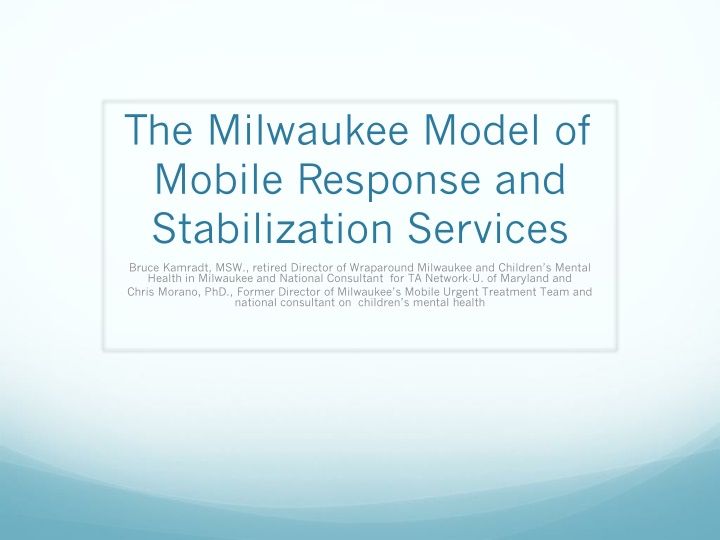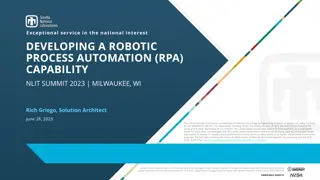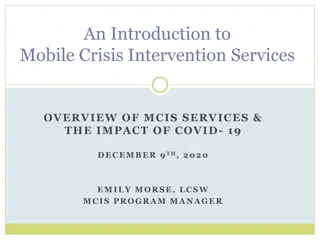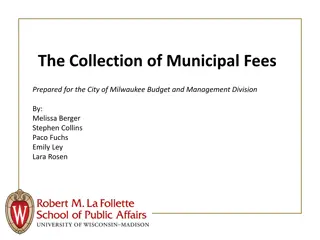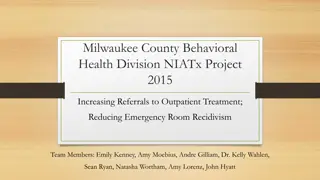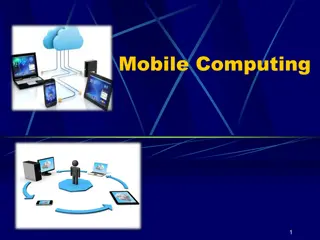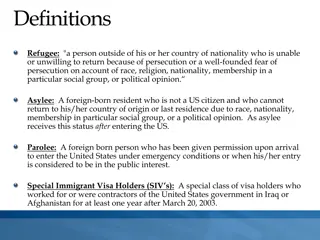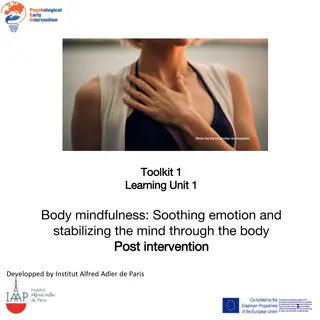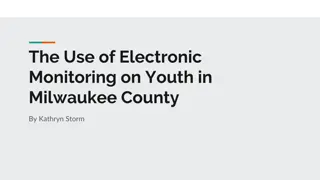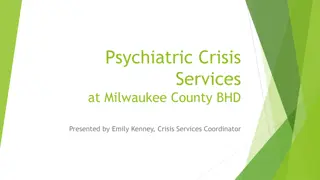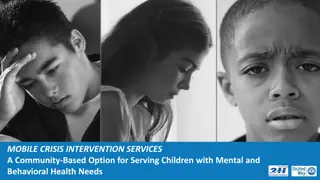Milwaukee Model of Mobile Response and Stabilization
Milwaukee County's Mobile Crisis Response Services, part of the Wraparound Milwaukee System of Care, evolved over the years to provide crisis intervention and stabilization services for children with serious emotional and mental health needs. The Mobile Urgent Treatment Team aims to keep youth enrolled in the System of Care at home and out of inpatient psychiatric care whenever possible. Funding was created under the Wisconsin State Medicaid Program to cover costs associated with mobile crisis response and optional stabilization services.
Uploaded on Mar 01, 2025 | 0 Views
Download Presentation

Please find below an Image/Link to download the presentation.
The content on the website is provided AS IS for your information and personal use only. It may not be sold, licensed, or shared on other websites without obtaining consent from the author.If you encounter any issues during the download, it is possible that the publisher has removed the file from their server.
You are allowed to download the files provided on this website for personal or commercial use, subject to the condition that they are used lawfully. All files are the property of their respective owners.
The content on the website is provided AS IS for your information and personal use only. It may not be sold, licensed, or shared on other websites without obtaining consent from the author.
E N D
Presentation Transcript
The Milwaukee Model of Mobile Response and Stabilization Services Bruce Kamradt, MSW., retired Director of Wraparound Milwaukee and Children s Mental Health in Milwaukee and National Consultant for TA Network-U. of Maryland and Chris Morano, PhD., Former Director of Milwaukee s Mobile Urgent Treatment Team and national consultant on children s mental health
I) Background/History 1. Milwaukee County s Mobile Crisis Response Services were developed over 20 years ago as part of development of Wraparound Milwaukee, the county s System of Care(SOC) for children with serious emotional and mental health needs 2. Named the Mobile Urgent Treatment Team, it began as a service to children in Wraparound with the primary goal to keep youth enrolled in the SOC at home and out of inpatient psychiatric care unless truly needed 3.Goal to contain and manage crisis in the home and community so the family plan and vision wouldn t be disrupted
Background/History(Cont.) 4. A change in State law in 1996 required all Wisconsin counties to plan for and provide crisis services(HFS34) to children and adults 5. Consistent with HFS34 funding was created under the Wis. State Medicaid Program to cover costs associated with the provision of mobile crisis response and optional stabilization services 6. The Mobile Urgent Treatment Team under the organization and direction of Wraparound Milwaukee and Milwaukee County s Children s Mental Health Division than evolved to be available to every child in Milwaukee County but also retained it s gatekeeper functions for WAM youth
Background/History(Cont) 7. An array of Crisis stabilization services permitted under HFS34 began to be developed and funded in Milwaukee county in 2002 including crisis group home and crisis 1:1 stabilizers 8. A Contract was entered into in 2005 with Child Welfare for creation of a dedicated foster care crisis team due to excessive placement disruptions and response to federal lawsuit 9. Contract with Milw. Public Schools in 2006 for specialized crisis team, grades 6-12, respond to school aggression, suspensions, etec.(ended in 2010 due to loss of state funds) 10. MUTT/Milw. Police Dept Trauma team developed in 2015 based on Yale Child Studies Model of Police, Mental health partnership
The Need for Mobile Response Services 1. Over utilization of emergency room visits and psychiatric hospitalization of children and adolescents 2. Too many children going into residential treatment centers directly from psychiatric hospitals 3. Excessive psychiatric hospitalization and RTC care was staining Medicaid budget and budgets of child welfare and Juvenile Justice 4. Children often did not require hospitalization or RTC care but alternatives for immediate assessment and treatment in the community were lacking
Defining Crisis A situation caused by an individual s apparent mental disorder which results in a high level of stress or anxiety for the individual, persons providing care for the individual or the public which cannot be resolved by the available coping methods of the individual or by the efforts of those providing ordinary care or support for the individual ( HFS34)
II) Components of a Crisis Service 1. Telephone service--qualified and trained staff, 24/7, providing callers with information, support, counseling, intervention, emergency service coordination and referral. (this is provided directly by MUTT staff from a central office and dedicated crisis line) 2. Mobile Crisis Service provides onsite, in-person intervention for persons experiencing a mental health crisis; available to make home visits and in other locations in the community; Staff must be qualified under state HFS34 requirements. (this is provided directly by MUTT staff)
Mobile Crisis Components(Cont.) 3. Walk-in Services face to face support at an identified location; MUTT uses psychiatric crisis service in emergency room of County Psychiatric facility 4. Short-term hospitalization (if needed) MUTT maintains agreement with the County s Child and Adolescent Inpatient Service 5. Linkage and Coordination Services connects child and family to on-going services ie WrapMilw. 6. Stabilization Services
Crisis Stabilization Services 1. Services to reduce or eliminate individuals symptoms of mental illness to prevent need for inpatient hospitalization or assisting in the transition of the child to a less restrictive placement or living arrangement when the crisis has passed 2. an array of crisis stabilization services have been developed by Wraparound Milwaukee to be used in conjunction with and under the direction of the Mobile Urgent Treatment Team
Types of Crisis Stabilization Services 1. Crisis/Respite Group Home 8 bed group home to divert youth from hospitalization, placement authorized by MUTT for up to 14 days 2. Crisis beds in Residential Treatment Centers crisis beds designated in a RTC for short-term placement up to 14 days(rate negotiated with RTC) 3. Crisis beds in Treatment Foster Homes(purchased on a case by case basis) 4. Peer to Peer Support Some done by Families United of Milwaukee via WrapMilw.
Types of Stabilization Services(Cont.) 5. 1:1 Crisis Stabilizers these are short-term services provided in the home, school and community to evaluate, manage, monitor, stabilize and support youth s well-being and appropriate behavior consistent with Crisis Plan and to prevent another crisis from occurring. Stabilizers have BA/BS degree or H.S. diploma Trained, Supervised by MUTT Clinicians Work under Crisis/Safety Plan
Required Staff for Mobile Response Team 1. Program Administrator and Clinical Director can be the same person 2. Professional staff licensed by state. If under 3000 hours of supervised clinical experience must have one hour of supervision for every 30 clock hours of face to face time. If over 3000 hours it is one hour of peer clinical consultation for every 120 hours of face to face time 3. New staff have 40 hour orientation training(20 hours if over 6 months emergency work experience)
Components of the Crisis Response for Families 4. Linkage and follow-up includes review and update of the crisis plan, follow-up intervention prescribed in the Crisis Plan, follow-up evaluations or referral options, coordinating with resources needed to respond to crisis and support individual and caregiver, assist in transition to least restrictive level of care 5. Optional Stabilization Services only covered and used to reduce mental health symptoms and eliminate risk of re-occurance of crisis or assist in transition to community. Stabilizers can go into the home, school, clinic or anywhere in the community
Components of the Mobile Response for Families 1. Initial Contact and Assessment circumstances resulting in the mobile crisis team contact, primary concerns of the individual or person making contact for the individual, individual s mental status and physical condition, if the individual is threatening harm to self or others and availability of means to carry out that threat, alcohol or drug use, names of people available if necessary to support individual 2. Response Plan provision of services and referrals necessary to reduce or de-escalate crisis and help recipient return to a safe level of functioning
Components of the Mobile Response for Families 3. Development of the Crisis Plan Demographic Information, How do we define crisis for this youth, what strengths can we use, special risks we need to be aware of, family and community supports we can contact and use, places in the community that might help, how we can help the caregiver, specific steps/actions to be taken, relevant medical information includes taking of medications and diagnostic label
III) Relationship of MUTT to County System of Care 1. MUTT works under auspices of Wraparound Milwaukee re administration, funding, contracting, etec. 2. MUTT serves as gatekeeper for inpatient hospitalization for WrapMilw. 3. MUTT makes assessments re. eligibility for and enrollment in Wraparound Milwaukee it links children seen in a crisis who have a serious emotional and mental health need to on-going care and services
Relationship To System of Care(Cont.) 4. MUTT serves as consultant to the Care Coordinators and Child and Family Teams to help develop and support Crisis/Safety Plans developed as part of the Plan of Care 5. Oversee the provision of services by the 1:1 crisis stabilizers who are extensively used by the CFT teams
Composition of Mobile Urgent Treatment Team 1. Mobile Urgent Treatment Team 20 MSW social workers, 3 PhD psychologists, one RN, consulting psychiatry services as needed 2. 24/7 availability( pager from 11pm-7am) 3. Two person teams 4. Preferred Provider arrangement with County Inpatient Psychiatric Unit 5. 3000 calls received in 2015, 1800 face to face contacts
Crisis 1:1 Stabilizers Paraprofessionals HFS34/emergency services certified HS degree Available 24/7 Personal relationship
Strategic Community Partnerships 1. Behavioral Health Division Coordinate with adult crisis program, inpatient, etec. 2. Wis. Medicaid Program funding, HFS34 regs. 3. Bureau of Milwaukee Child Welfare funding for foster care crisis team to reduce placement disruption 4. Milwaukee Public Schools funding to create crisis team to reduce school aggressions, suspensions, etec 5. Milw. Police Dept. crisis training for officers, creation of police trauma response team 6. Families United of Milwaukee Advocacy and peer support in community
Unique MOU between MUTT and Child Welfare 1. Since 2004, The Bureau of Milwaukee child Welfare and Wraparound Milwaukee and MUTT have had a contract to provide a dedicated crisis team for children in foster care system--$750,000 2. As part of remedy to a federal lawsuit and resulting consent decree to reduce the number of failed placements ie number of foster care moves in a single year 3. Has resulted in 90% of referred youth being stabilized in foster home
IV) Funding Strategies to Support Mobile Crisis in Milwaukee 1. Medicaid covers mobile crisis response and stabilization services based on performing provider under (HFS34) but only for 60% of costs, Milwaukee County is expected to cover any remaining costs 2. Wraparound Milwaukee thru Pooled funds and re-directed savings from reduced hospital and RTC costs cover much of remaining costs of MUTT 3. MUTT has $750,000 contract with child welfare for dedicated crisis service to foster homes 4. City of Milwaukee provides $90,000 contract for new MUTT/Police Trauma Unit 5. Milw. Delinquency and Court Services provide funding( $8 million per year) for Wrap services to their youth including provision of crisis services 6. Wraparound Milwaukee functions as special managed care entity under 1915a and receives capitated PCPM payments including cost of inpatient hospital and 50% of RTC and TFC so it can redirect savings in these areas to cover community services such as the MUTT team.
Current WI. Medicaid Fee Schedule for Crisis Service Psychiatrist--$148.16 per hour(state reimburses federal share at 60% or $85.15 per hour Advanced Practice RN(same as above) PhD Psychologist--$110.23 per hour(state reimburses $63.35) Master s degree or BA/BS--$88.90(state reimburses $51.09) Paraprofessional--$44.00 per hour =$27.50 Per diem for Group home/RTC--$139.54 per day(Medicaid reimburses at $80.19 per day)
What Medicaid Covers for Crisis Intervention in Wis. 1. May only pay County Human Service Agencies to provide crisis intervention or agencies with whom they contract to provide crisis services 2. Agencies must be certified under HFS34 3. Recipients being discharged from a hospital or residential treatment center are eligible for crisis services if they are likely to experience another crisis if these services are not provided 4. Recipients in a hospital or residential treatment are eligible to receive crisis services if needed to develop a crisis plan or to facilitate transition back to their home or community
Outcomes Supporting MUTT Sustainability over 20 years 1. reduction in utilization of inpatient psychiatric hospitalization. There was a reduction in inpatient psychiatric bed days within initial year of implementation for youth with severe emotional disturbance from 5000 days to 500 days 2. WAM Average utilization per month per child for inpatient care over the past 20 years has ranged from 1.5% to 3.5% of total expenditures. That equates today to pcpm of about $78 per member per month(1230 current enrolled SED youth) 3. Child Welfare has seen significant reduction in failed foster Placements since initiation of dedicated MUTT services. Nearly 90% of youth seen by MUTT have been stabilized in their current foster care placement 4. There has been a reduction in child and adolescent bed capacity in Milwaukee County from about 300 to 125 beds
Outcomes(Cont.) 5. Average length of stay in psychiatric inpatient care for youth managed thru mobile urgent treatment team is 2.4 days versus average stays of nearly 70 days before MUTT assumed gate-keeper duties 6. Average response time on calls going into the community for MUTT has been only 20 minutes 7. MUTT has received high consumer satisfaction per survey 8. MUTT provides CPI training to all Milwaukee Police Dept. Officers
Information Technology Needed and Used by MUTT 1. Access to good data system is critical for a mobile response team 2. MUTT uses synthesis, an electronic health record and data system developed and used by Wraparound Milwaukee 3. MUTT enters data from all contacts and work with families into the system including, assessments, crisis plans, authorized services and providers, progress notes, etec.
Information Technology(Cont.) 4. Synthesis converts progress notes into billing documents that go electronically to medicaid 5. MUTT and WrapMilw. Use a single release of information allowing case data to be shared and viewed on-line. MUTT can see care plans and crisis safety plans, care coordination notes, provider notes, etec. MUTT plans and progress notes can than be viewed by Wraparound Care Coordinators. Juvenile Justice also uses system 6. Internet-based IT system is needed so you are not flying blind into crisis situations
V) Beginning a Program Understand your community- who are your stakeholders? Meet with them, find out their needs Make it clear you need to partner with them Include Families! Develop a Mission Statement Your Intent for your community Hire staff Train them..but more importantly.. Guide, support, supervise regularly, encourage, role model for them, recognize THEIR needs! Make routines for them- more on this later Establish Expectations, expected outcomes- Key
MUTT Mission To serve each youth and family with respect and dignity acknowledging their strengths, needs and preferences To partner with agencies that work with families to create a coordinated, holistic plan for a better life To support youth and families to remain safely in their homes and communities To provide quality care that is culturally responsive to the diverse needs of families we serve To provide leadership in creating lasting resources to promote the health and well-being of families in their communities
